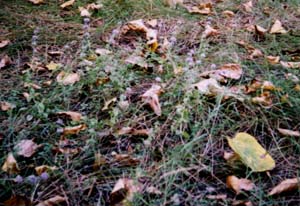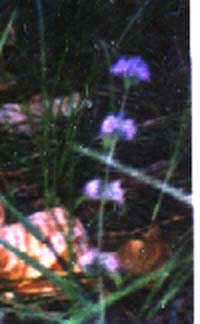

General Species Description
- Mentha Arvensis is an erect herbacious perennial plant that grows 20 - 80 cm tall on square, hairy stems. It is rhizomatous and has opposite leaves that are attached to the stem with very short stalks. It has a very fragrant minty aroma.
Leaves
- The leaves are 2 - 8 cm long and 6 - 40 mm wide. They are lance to oval shaped, taper to a point, and have sharply toothed margins.
Inflorescence/Flowers
- The flowers are whorled around the upper leaf axils. They are 4 - 7 mm long, 2 lipped, irregular, and range from white to pink to violet. They have longer stamens than petals. They bloom from June to August.
Fruits
- The fruits are brown nutlets. There are four per flower and they enlarge and remain on the plant into the winter.
Habitat
- Mentha arvensis grows in moist places; along shorelines and streambanks, in wet meadows, prairies, and ditches, and in open spaces in shrub swamps. It is found from low to moderate elevations. Juncus species and Veronica species are commonly found with the Menthas.
Range
- Mentha arvensis is found all the way around the north pole, extending as far south as New Mexico. It is the only native mint species here in the northwest, and is also the most common. It is found extensively west of the Cascades.
Similar Species
- Lycopus americanus and lycopus uniflorus both have square stems. They, however, do not have a strong odor. They have fewer, smaller flowers, and the petals are smaller than the stigmas. Mentha spicata and Mentha piperita can be distinguished by their terminal inflorescence.
Ecological Value
- The fruits of mentha arvensis are widely used as a food source for small animals.
Human Value
- Native Americans used field mint tea for colds. Today we still use it for medicinal purposes. It is widely used for upset stomachs, gas, and sore throats. It can also be used for culinary purposes, and in hygeine products.
References
- Cooke, Sarah Spear, ed. A Field Guide to the Common Wetland Plants of Washington and Northwestern Oregon. 1997. Seattle Audubon Society. Seattle, Washington. Guard, B. Jennifer. Wetland Plants of Oregon and Washington. 1995. Lone Pine Publishing. Vancouver, B.C., Canada.
This page was created by: Braden Hanna, August 1998
Return to Northwest Oregon Wetland Plants Project